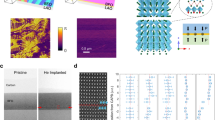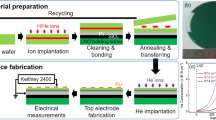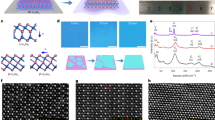Abstract
Interfacial ‘dead’ layers between metals and ferroelectric thin films generally induce detrimental effects in nanocapacitors, yet their peculiar properties can prove advantageous in other electronic devices. Here, we show that dead layers with low Li concentration located at the surface of LiNbO3 ferroelectric materials can function as unipolar selectors. LiNbO3 mesa cells were etched from a single-crystal LiNbO3 substrate, and Pt metal contacts were deposited on their sides. Poling induced non-volatile switching of ferroelectric domains in the cell, and volatile switching in the domains in the interfacial (dead) layers, with the domain walls created within the substrate being electrically conductive. These features were also confirmed using single-crystal LiNbO3 thin films bonded to SiO2/Si wafers. The fabricated nanoscale mesa-structured memory cell with an embedded interfacial-layer selector shows a high on-to-off ratio (>106) and high switching endurance (~1010 cycles), showing potential for the fabrication of crossbar arrays of ferroelectric domain wall memories.
This is a preview of subscription content, access via your institution
Access options
Access Nature and 54 other Nature Portfolio journals
Get Nature+, our best-value online-access subscription
$29.99 / 30 days
cancel any time
Subscribe to this journal
Receive 12 print issues and online access
$259.00 per year
only $21.58 per issue
Buy this article
- Purchase on Springer Link
- Instant access to full article PDF
Prices may be subject to local taxes which are calculated during checkout





Similar content being viewed by others
Data availability
The data sets generated and analysed during this study are available from the corresponding authors on reasonable request. Source data for Figs. 1–5 and for the figures and tables in the Supplementary Information are provided with the paper.
References
Shimojo, Y. et al. High-density and high-speed 128Mb chain FeRAM™ with SDRAM-compatible DDR2 interface. In Symposium on VLSI Technical Digest 218–219 (Japan Society of Applied Physics, 2009).
Kohlstedt, H. et al. Current status and challenges of ferroelectric memory devices. Microelectron. Eng. 80, 296–304 (2005).
Sharma, P. et al. Nonvolatile ferroelectric domain wall memory. Sci. Adv. 3, e1700512 (2017).
Jiang, J. et al. Temporary formation of highly conducting domain walls for non-destructive read-out of ferroelectric domain-wall resistance switching memories. Nat. Mater. 17, 49–55 (2018).
Seidel, J. et al. Conduction at domain walls in oxide multiferroics. Nat. Mater. 8, 229–234 (2009).
Farokhipoor, S. & Noheda, B. Conduction through 71° domain walls in BiFeO3 thin films. Phys. Rev. Lett. 107, 127601 (2011).
Crassous, A., Sluka, T., Tagantsev, A. K. & Setter, N. Polarization charge as a reconfigurable quasi-dopant in ferroelectric thin films. Nat. Nanotechnol. 10, 614–618 (2015).
Wu, W., Horibe, Y., Lee, N., Cheong, S.-W. & Guest, J. R. Conduction of topologically protected charged ferroelectric domain walls. Phys. Rev. Lett. 108, 077203 (2012).
Meier, D. et al. Anisotropic conductance at improper ferroelectric domain walls. Nat. Mater. 11, 284–288 (2012).
Schröder, M. et al. Conducting domain walls in lithium niobate single crystals. Adv. Funct. Mater. 22, 3936–3944 (2012).
Godau, C., Kämpfe, T., Thiessen, A., Eng, L. M. & Haußmann, A. Enhancing the domain wall conductivity in lithium niobate single crystals. ACS Nano 11, 4816–4824 (2017).
Werner, C. S. et al. Large and accessible conductivity of charged domain walls in lithium niobate. Sci. Rep. 7, 9862 (2017).
Sluka, T., Tagantsev, A. K., Bednyakov, P. & Setter, N. Free-electron gas at charged domain walls in insulating BaTiO3. Nat. Commun. 4, 1808 (2013).
Volk, T. R., Gainutdinov, R. V. & Zhang, H. H. Domain-wall conduction in AFM-written domain patterns in ion-sliced LiNbO3 films. Appl. Phys. Lett. 110, 132905 (2017).
Ma, J. et al. Controllable conductive readout in self-assembled, topologically confined ferroelectric domain walls. Nat. Nanotechnol. 13, 947–952 (2018).
Bai, Z. L. et al. Hierarchical domain structure and extremely large wall current in epitaxial BiFeO3 thin films. Adv. Funct. Mater. 28, 1801725 (2018).
Stolichnov, I. et al. Persistent conductive footprints of 109° domain walls in bismuth ferrite films. Appl. Phys. Lett. 104, 132902 (2014).
Rojac, T. et al. Domain-wall conduction in ferroelectric BiFeO3 controlled by accumulation of charged defects. Nat. Mater. 16, 322–327 (2017).
Linn, E., Rosezin, R., Kügele, C. & Waser, R. Complementary resistive switches for passive nanocrossbar memories. Nat. Mater. 9, 403–406 (2010).
Yoon, K. J. et al. Double-layer-stacked one diode-one resistive switching memory crossbar array with an extremely high rectification ratio of 109. Adv. Electron. Mater. 3, 1700152 (2017).
Wang, G. et al. High-performance and low-power rewritable SiOx 1 kbit one diode-one resistor crossbar memory array. Adv. Mater. 25, 4789–4793 (2013).
Sinnamon, L. J., Bowman, R. M. & Gregg, J. M. Investigation of dead-layer thickness in SrRuO3/Ba0.5Sr0.5TiO3/Au thin-film capacitors. Appl. Phys. Lett. 78, 1724–1726 (2001).
Stengel, M. & Spaldin, N. A. Origin of the dielectric dead layer in nanoscale capacitors. Nature 443, 679–682 (2006).
Lu, H. et al. Electrical tunability of domain wall conductivity in LiNbO3 thin films. Adv. Mater. 48, 1902890 (2019).
Zhang, Y. & Jiang, A. Q. Low-frequency charge trapping and bistable domain switching in Mg-doped LiNbO3 single crystal films. J. Appl. Phys. 124, 124103 (2018).
Jiang, J., Meng, X. J., Geng, D. Q. & Jiang, A. Q. Accelerated domain switching speed in single-crystal LiNbO3 thin films. J. Appl. Phys. 117, 104101 (2015).
Domingo, N., Narvaez, J., Alexe, M. & Catalan, G. Local properties of the surface layer(s) of BiFeO3 single crystals. J. Appl. Phys. 113, 187220 (2013).
Ravikumar, V., Wolf, D. & Dravid, V. P. Ferroelectric-monolayer reconstruction of the SrTiO3 (100) surface. Phys. Rev. Lett. 74, 960–963 (1995).
Martí, X. et al. Skin layer of BiFeO3 single crystals. Phys. Rev. Lett. 106, 236101 (2011).
Sanna, S. & Schmidt, W. G. Lithium niobate X-cut, Y-cut, and Z-cut surfaces from ab initio theory. Phys. Rev. B 81, 214116 (2010).
Gonnissen, J. et al. Direct observation of ferroelectric domain walls in LiNbO3: wall-meanders, kinks, and local electric charges. Adv. Funct. Mater. 26, 7599–7604 (2016).
den Dekker, A. J., Gonnissen, J., De Backer, A., Sijbers, J. & Van Aert, S. Estimation of unknown structure parameters from high-resolution (S)TEM images: what are the limits? Ultramicroscopy 134, 34–43 (2013).
So, Y. W., Kim, D. J., Noh, T. W., Yoon, J. –G. & Song, T. K. Polarization switching kinetics of epitaxial Pb(Zr0.4Ti0.6)O3 thin films. Appl. Phys. Lett. 86, 092905 (2005).
Merz, W. J. Domain formation and domain wall motions in ferroelectric BaTiO3 single crystals. Phys. Rev. 95, 690–698 (1954).
Tybell, T., Paruch, P., Giamarchi, T. & Triscone, J.-M. Domain wall creep in epitaxial ferroelectric Pb(Zr0.2Ti0.8)O3 thin films. Phys. Rev. Lett. 89, 097601 (2002).
Mankowsky, R., Hoegen, A. V., Först, M. & Cavalleri, A. Ultrafast reversal of the ferroelectric polarization. Phys. Rev. Lett. 118, 197601 (2017).
Jesse, S. et al. Direct imaging of the spatial and energy distribution of nucleation centres in ferroelectric materials. Nat. Mater. 7, 209–215 (2008).
Gruverman, A., Rodriguez, B. J., Kingon, A. I. & Nemanich, R. J. Spatial inhomogeneity of imprint and switching behavior in ferroelectric capacitors. Appl. Phys. Lett. 82, 3071–3073 (2003).
Anbusathaiah, V. & Nagarajan, V. High-resolution piezoresponse force microscopy investigation of imprint in ferroelectric thin films. Appl. Phys. Lett. 89, 132912 (2006).
Kalinin, S. V., Kim, Y., Fong, D. D. & Morozovska, A. N. Surface-screening mechanisms in ferroelectric thin films and their effect on polarization dynamics and domain structures. Rep. Prog. Phys. 81, 036502 (2018).
Setvin, M. et al. Polarity compensation mechanisms on the perovskite surface KTaO3(001). Science 359, 572–575 (2018).
Han, H., Cai, L., Xiang, B., Jiang, Y. & Hu, H. Lithium-rich vapor transport equilibration in single-crystal lithium niobate thin film at low temperature. Opt. Mater. Express 5, 2634–2641 (2015).
Micheloni, R., Crippa, L., Zambelli, C. & Olivo, P. Architectural and integration options for 3D NAND flash memories. Computers 6, 27 (2017).
Jiang, A. Q. & Zhang, Y. Next-generation ferroelectric domain-wall memories: principle and architecture. NPG Asia Mater. 11, 2 (2019).
Fong, D. D. et al. Ferroelectricity in ultrathin perovskite films. Science 304, 1650–1653 (2004).
Salje, E. K. H. Ferroelastic materials. Annu. Rev. Mater. Res. 42, 265–283 (2012).
Perdew, J. P., Burke, K. & Ernzerhof, M. Generalized gradient approximation made simple. Phys. Rev. Lett. 77, 3865 (1996).
Kresse, G. & Furthmüller, J. Efficient iterative schemes for ab initio total-energy calculations using a plane-wave basis set. Phys. Rev. B 54, 11169 (1996).
Kresse, G. & Furthmüller, J. Efficiency of ab initio total energy calculations for metals and semiconductors using a plane-wave basis set. Comput. Mater. Sci. 6, 15 (1996).
Acknowledgements
This work was supported by the Basic Research Project of Shanghai Science and Technology Innovation Action (grant number 17JC1400300), the National Key R&D Programme of China (number 2019YFA0308500), the National Natural Science Foundation of China (grant numbers 61674044 and 11572040), the Programme of Shanghai Subject Chief Scientist (grant number 17XD1400800) and the Beijing Natural Science Foundation (grant number Z190011). J.F.S. acknowledges the financial support of the Strategic Priority Research Programme of the Chinese Academy of Sciences (grant number XDB07030200). C.S.H. acknowledges the support by Samsung Research Funding & Incubation Center of Samsung Electronics under project number SRFC-TA1703-02. Theoretical calculations were performed using resources of the National Supercomputer Centre in Guangzhou. We thank D. MacDonald from Liwen Bianji, Edanz Editing China (www.liwenbianji.cn/ac), for editing the English text of a draft of this manuscript. This work is dedicated to the memory of J.F.S., who passed away on 6 April 2020.
Author information
Authors and Affiliations
Contributions
A.Q.J. conceived the idea for the work and performed electrical characterization, and, along with D.W.Z., J.F.S. and C.S.H., directed the study, analysed the results and wrote the manuscript. W.P.G., J.J., C.W., J.W.L. and Y.Z. carried out the nanodevice fabrication and measured the X-ray diffraction patterns, P.L. and J.-w.H. performed the first-principles calculations, and X.J.C. and R.H. performed the TEM observations. All the authors discussed the results.
Corresponding authors
Ethics declarations
Competing interests
The authors declare no competing interests.
Additional information
Publisher’s note Springer Nature remains neutral with regard to jurisdictional claims in published maps and institutional affiliations.
Supplementary information
Supplementary Information
Supplementary Figs. 1–14, Notes A–L and Table 1.
Supplementary Data
Source data for figures and tables in Supplementary Information.
Source data
Source Data Fig. 1
Experimental data points of Fig. 1c, f–i.
Source Data Fig. 2
Experimental data points of Fig. 2b,d.
Source Data Fig. 3
Experimental data points of Fig. 3a,b.
Source Data Fig. 4
Experimental data points of Fig. 4c,f.
Source Data Fig. 5
Experimental data points of Fig. 5a–i.
Rights and permissions
About this article
Cite this article
Jiang, A.Q., Geng, W.P., Lv, P. et al. Ferroelectric domain wall memory with embedded selector realized in LiNbO3 single crystals integrated on Si wafers. Nat. Mater. 19, 1188–1194 (2020). https://doi.org/10.1038/s41563-020-0702-z
Received:
Accepted:
Published:
Issue Date:
DOI: https://doi.org/10.1038/s41563-020-0702-z
This article is cited by
-
A ferroelectric fin diode for robust non-volatile memory
Nature Communications (2024)
-
Switchable tribology of ferroelectrics
Nature Communications (2024)
-
In-situ artificial retina with all-in-one reconfigurable photomemristor networks
npj Flexible Electronics (2023)
-
Recent progress in ferroelectric synapses and their applications
Science China Materials (2023)
-
Nonvolatile ferroelectric domain wall memory integrated on silicon
Nature Communications (2022)



